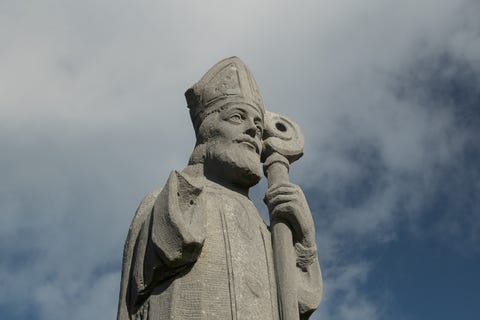Tomorrow is St. Patrick’s Day, a day most known for drinking green beer and watching parades. But who was the real St. Patrick, the "Apostle of Ireland, the country’s primary patron saint?
A Short History
Patrick was born around 385 AD. He was kidnapped from his home in southern Britain as a teenager, sold into slavery, and taken to Ireland. Six years later, he escaped and made his way back to his home in Roman Britain, which was believed to be modern-day England, Wales, or Scotland.
After returning home, Patrick was called through a dream to serve God and to begin his religious training. It is believed that he traveled to Gaul (modern-day France) to study for the priesthood. He likely trained at Lérins Abbey, off the southern coast of France, or at Auxerre, under the guidance of St. Germain, the most respected bishop and theologian of his day. During his years of study, Patrick deepened his knowledge of Christian doctrine, Latin, and the Bible.
During those early years, Bibles were securely kept in churches and monasteries. Translations had been completed in 405 AD by Jerome, a Christian scholar, priest, and theologian, best known for his Bible translation known as the Vulgate. His work became the standard Latin Bible of the Catholic Church for over a thousand years. The Council of Trent extended this by declaring the Vulgate the official Latin Bible of the Church in 1546. Jerome died in 420 AD and was later canonized as Saint Jerome, recognized by the Church for his contributions to biblical scholarship.
Jerome translated the Old Testament directly from Hebrew rather than the Greek Septuagint, arguing that it was closer to the original text. The New Testament was translated primarily from Greek manuscripts. Subsequent Biblical texts were handwritten copies, made by scribes and monks. Each word had been copied onto parchment or vellum, a high-quality calfskin. Because of the time and labor required, Bibles were rare and expensive.
After becoming a priest, Patrick continued his theological training and gained experience in Church leadership. Eventually, he was ordained as a bishop. According to his writings in the Confessio, he had a dream in which God told him to return to Ireland. So, in AD 432, 25 years after fleeing Ireland, Patrick set out to return to the place of his bondage. Although the exact details of his return journey are not recorded in his writings, he likely traveled to Ireland on a ship.
Patrick entered an Ireland full of paganism and idol worship, yet he lived in a way that honored God. His devotion and steadfast obedience provided examples for others, inspiring them to become followers of Christ. Within just a few decades after his arrival, a vibrant, Christ-honoring church community had developed and was flourishing. It is said that he converted around 120,000 Irish people to Christ, established 300 churches, and a monastery. Known as the "Apostle of Ireland," he is the principal patron saint of Ireland.
St. Patrick’s Day
The day originally began as a feast day to honor St. Patrick and his efforts to convert the Irish to Christianity. Celebrated on March 17 (the date of St. Patrick's death, believed to be in 461 AD), it was a religious observance marked by church services, prayers, and reflection on Patrick's work.
However, over time, St. Patrick’s Day began to take on a festive element that included feasts, simulated battles, and community gatherings. When a large influx of Irish immigrants came to the U.S. in the mid-1800s, St. Patrick's Day became an opportunity to celebrate Irish heritage and culture. The holiday came to represent Irish pride, with large parades, public festivals, and performances. As the celebration became more secular, alcoholic beverages became an important part of the celebration, particularly in cities like New York and Boston, where large Irish populations reside.
In the 20th century, beer companies and alcohol producers began to see St. Patrick’s Day as a marketing opportunity. When they began to heavily promote the idea of celebrating the Day with alcohol, particularly Irish brands like Guinness beer and Jameson whiskey, the association between the day and drinking grew stronger and is now a prominent fixture of St. Patrick’s Day. Countries around the world adopted the festivities, focused on fun and drinking. Long lost is the solemn, prayerful feast day honoring the Saint's Christian mission and remembering a man’s legacy of lead millions to the Lord
Bringing Back the True Celebration
According to legend, when St. Patrick was trying to explain the Christian doctrine of the Trinity — the belief that God the Father, God the Son, and God the Holy Spirit are three distinct persons but one God — he used the shamrock as a simple, visual illustration. The shamrock, a three-leafed plant, served as an effective symbol because it clearly demonstrated how three separate parts could be united in one. Each leaf represented one of the persons of the Trinity, but together they formed one shamrock, just as the Father, Son, and Holy Spirit are distinct but united in one divine essence.
How adulterated has that become?
To bring back the true spirit of St. Patrick's Day and honor his legacy of faith and service, we can make an effort to focus on his Christian ministry rather than the secular festivities. One meaningful way to start the day is by attending a Mass if you are a Catholic or participating in a prayer service that celebrates his work of spreading Christianity to Ireland. Following his example, we can also set aside the day to serve others, whether through volunteering at a local charity, spending time with someone in a nursing home, or simply helping those in need.
Celebrating Irish culture is important, but we can focus on the Christian aspects of this important community, such as learning the stories of other Irish saints - there are many, at least 10! - who contributed to the faith. Sharing the stories of St. Patrick’s life and missionary work with others, especially children, helps to convey the deeper meaning of the day.
By incorporating these practices, we can reclaim St. Patrick's Day as a celebration of faith and service, focusing on the saint's mission to spread the Gospel rather than just a time of revelry.








I’m part Scots-Irish, and when I finally learned years ago about the Book of Kells (circa 800 AD), I understood St. Patrick’s devotion to God’s word and his faith in Christ. God sustained Patrick’s missionary efforts even to this day.
https://en.wikipedia.org/wiki/Book_of_Kells
Pray for Ireland as it now battles the potential destruction of its beautiful heritage.
Thank you, Doctor, have a Blessed and peaceful St. Patrick’s Day!